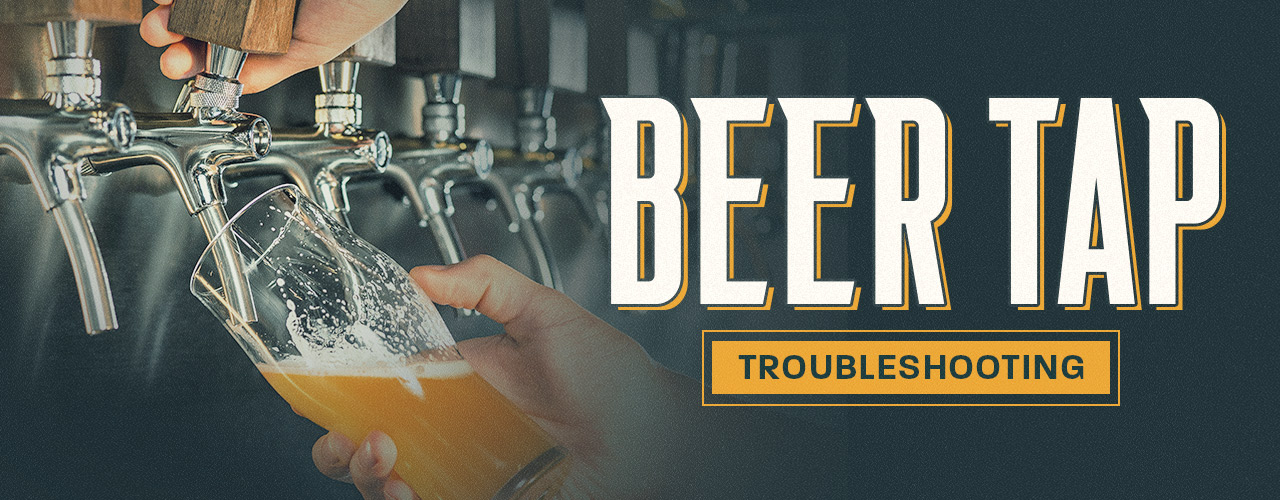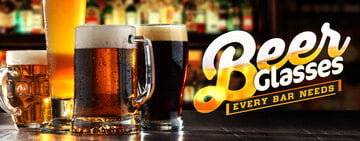
Part of running a successful bar business is knowing how to identify and resolve common draft system problems when they inevitably arise. This guide will go over how to troubleshoot various beer tap problems so you can train your bartenders to calmly and quickly handle the issues as soon as they happen.
Keg Is Not Pouring

If the keg is not dispensing beer or the beer is coming out of the tap too slowly, here are some easy troubleshooting tips to ensure you get your beer flowing again quickly:
- Your keg is empty. Replace the empty one with a fresh keg. You can also use a keg check to see the current levels in your keg.
- Your gas cylinder is empty. Replace or refill your tank. A double gauge regulator can be a handy investment for your tank because it has a regulated pressure gauge and it also shows how much is left in your tank.
- The gas is turned off. Your CO2 should be left on unless there are leaks or you need to change out the cylinder.
- Your keg is tapped incorrectly. Make sure your keg has been tapped correctly.
- The beer lines are frozen. Thaw out the frozen lines. Make sure that the beer is being stored at an appropriate temperature, generally between 36 - 38 degrees Fahrenheit, to avoid freezing, which can cause ice to back up into your beer line. If ambient temperature is the problem, consider insulating the beer lines.
Beer Is Foamy

Beer that is too foamy is one of the most common problems bartenders and bar owners will encounter. The good news is that this is a very easily fixed problem. Here are some of the main causes of foamy beer and how to fix them:
- The draft cooler is too warm. The cooler should be kept between 36 - 38 degrees Fahrenheit.
- Your glasses are frozen. When beer comes into contact with a glass that is too cold, it can cause the beer to foam up. You should also never freeze your glasses because they can freeze water in the beer and numb customers' taste buds to the delightful flavors of your brews.
- The beer lines are too warm or cold. Make sure that your beer line systems are refrigerated or insulated according to the type of beer you're offering. Lines should be kept at the proper serving temperature for each beer.
- The beer is being improperly dispensed. Make sure your staff is trained on how to properly pour draft beer.
- There is too much pressure in your system. Generally, U.S. ales and lagers are dispensed at 10 - 12 PSI, while stouts and other styles are dispensed at 25 - 30 PSI (adding 1 PSI for each 2000 ft. increment above sea level).
- The taps are dirty or malfunctioning. Foamy beer may result from dirty beer lines, so be sure to clean your beer tap system thoroughly. If cleaning doesn't resolve the situation, you may need to have your system serviced by a professional, or some parts may need to be replaced.
- Your keg is tapped incorrectly. Make sure your keg has been tapped correctly at the right temperature. Avoid agitation in the keg before tapping.
- The tap lines are obstructed or damaged. Check that all lines are clear and free of kinks, dents, twists, or obstructions.
Beer Is Flat

Nothing is worse than getting a beer that is flat and tasteless. Ensure that you're serving your guests delicious and carbonated beverages with these simple fixes:
- Your beer is too cold. Barrels should be stored between 36 - 38 degrees Fahrenheit, while the lines should be refrigerated or insulated to properly maintain the serving temperature of the beer you're serving. Additionally, different types of beer are stored at different temperatures.
- The glasses haven't been properly cleaned. Glasses should be cleaned with specific bar glass chemicals since standard detergents are more likely to leave a film behind. Grease deposits and lint from towels can cause your beer to lose its head and have a flat appearance. So be sure to use the correct cleaner and let your glasses air dry.
- There is not enough pressure in your system. Make sure that your gas cylinder is set to the correct PSI and ensure that the coupler is securely attached.
- You're using an air compressor for pressure. Some establishments will try to use air compressors to dispense their beer to cut costs. Air will not carbonate your beer, resulting in a flat product. When dispensing beer, you must use either carbon dioxide or a mixture of carbon dioxide and nitrogen.
- There is an obstruction in the tap lines. Check the lines and clean thoroughly if necessary.
Beer Won't Hold a Head
While too much foam is an issue, not having any foam at the top of the beer is also an issue. A beer head affects the mouthfeel of the beer, enhances its aroma, and prevents all of the carbonation from escaping and becoming flat. If you're experiencing large, soap-like bubbles at the top or the head is dissolving too quickly, here are some things to look out for:
- You're using dry beer glasses. Flush the glasses with clean water and drain before pouring.
- The pressure required does not match the beer temperature. Research or consult your supplier for proper temperatures and pressures for each draft product.
- The coils in the beer lines are warmer than the beer in the keg. Check that the air hose clip in the draft tower is still in place. Check insulation for damage and repair as necessary.
Beer Is Cloudy
The ideal beer for most styles has a 1" head, is nicely carbonated, and is perfectly clear. But if your beer comes out cloudy, here are some ways you can fix it. It's important to note that some beers, like wheat beers, are supposed to be cloudy.
- The beer is over-chilled in the keg or beer lines. If the beer is too cold, ice can start forming, which causes the beer to become cloudy. Make sure that your beer is stored at the correct temperature.
- The beer lines or taps have not been adequately cleaned. Over time, yeast and sediment can build up in your draft lines or taps. This sediment can get into your beer and cause it to turn cloudy. You can prevent this by cleaning your beer tap system regularly and thoroughly.
- Your pressure source is contaminated. Carbon dioxide cylinders should be regularly inspected and maintained if they're being refilled instead of replaced. Otherwise, rust and other contaminants may build up inside and get into your beer. Some cylinders can be fitted with in-line purifiers that use carbon beads to remove contaminants.
Beer Tastes Bad

Nothing can hurt your reputation more than serving a beer that tastes or smells unusual. Here's how to prevent it from happening at yours:
- The beer lines or faucets are dirty. Buildup in the beer lines or faucet can affect the taste of your beer, so you should clean them regularly.
- The beer lines are not being flushed properly between kegs. Make sure you flush the lines thoroughly with clean water between each keg.
- The keg or beer lines are too warm. Check your beer dispenser's temperature setting and around the keg for hot spots.
- Your gas cylinders are contaminated. Check your gas tank for rust or contamination. You may need to swap it out for a different tank and have the contaminated tank cleaned.
- The beer glasses haven't been cleaned properly. If you use the wrong chemicals to clean your beer glasses, they can leave a small film that can cause your beer to taste off. Make sure that you're using specifically beer glass chemicals and sanitizer.
- You're serving old beer. Many breweries print a freshness date on kegs to help prevent you from holding onto a product for too long. As a general rule of thumb, a keg of non-pasteurized beer being dispensed with carbon dioxide will stay fresh for approximately 45 - 60 days, while a pasteurized beer will hold for between 90 - 120 days.
Back to Top
The beer tap system is an integral piece of equipment in any bar, so it’s necessary to know how to handle any problem that might come your way. Keep in mind that the issue might not be the equipment itself but other surrounding factors, such as incorrect temperatures, inadequate cleaning processes, or improper training, that are easy to fix.





